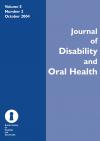Journal of Disability and Oral Health

- Cover Date:
- October 2004
- Print ISSN:
- 1470-8558
- Electronic ISSN:
- 1754-2758
- Vol:
- 5
- Issue:
- 2
Abstracts
The impact of oral disease among the institutionalized and non-institutionalized elderly in Hong Kong. McMillan AS, Wong MC, Lo EC, Allen PF. J Oral Rehabil. 2003 Jan; 30(1): 46–54. Quality of life is becoming an increasingly important consideration in clinical sciences and dentistry is no exception. This paper examines the impacts of oral disease on elderly people, aged 60–80 years, in Hong Kong, 268 of whom were in residential care and 318 living at home. In this study, the full Oral Health Impact Profile (OHIP) tool was used (49 items), alongside a clinical examination. Although the pattern of oral disease in the two subsets were different, the impact of oral health on these adults was low and similar between those in residential care and those resident at home. More general factors, in particular, those stemming from the different social and cultural backgrounds of the participants influenced their perception of the affects of oral disease. S p e c i a l Olympics: the oral health status of U.S. athletes compared with international athletes. Reid BC, Chenette R, Macek MD. Spec Care Dentist. 2003 Nov-Dec; 23(6): 230–233 Elsewhere in this issue details are published on the results from a Special Olympics screening of athletes in the Middle East and North Africa. This report, a comparison of the oral health of US versus international Special Olympics athletes highlights the better access of some to dental ser vices. International athletes tended to be younger (17.4 as against 24.0 years) than their US counterparts and more of the former were male ( 64.3% versus 62.9%). The oral health of international athletes as recorded using the screening criteria was, in most instances, considerably poorer than those in the US. The international athletes had more untreated caries (50.1% versus 28.2%), fewer restorations (19.6% versus 62.9%), less sealed teeth (1.8% versus 13.5%), less fluorosis (3.5% versus 8.8%) as well as fewer signs of gingival disease (27.8% versus 40.1%), and finally, less likely to be edentulous (0.1% versus 3.7%). General dentists’ perceptions of educational and treatment issues affecting access to care for children with special health care needs. Casamassimo PS, Seale NS, Ruehs K. J Dent Educ. 2004 Jan; 68(1): 23–28 This article is of relevance to BSDH and its Teacher’s Group in particular, since it chronicles dentists care for children with disabilities and their own attitudes towards education, both as undergraduates and for continuing education in special care dentistry. Very few of the US dentists surveyed saw children with disabilities but, not surprisingly, only 25% of them reported any undergraduate experience with this group of patients. Dentists who had had hands-on experience as undergraduates with such patients were less likely to see the degree of disability or behavioural problems as a barrier to dental care, and were more likely to express an interest in continuing education in this field.
- Article Price
- £15.00
- Institution Article Price
- £15.00
- Page Start
- 91
- Page End
- 91
- Authors
- Shelagh Thompson
Articles from this issue
- Title
- Pg. Start
- Pg. End
- Oral hygiene and periodontal treatment needs in young people with special needs attending a special school in Greece
- 57
- 64
- The oral health status of the Special Olympics Special Smiles (SOSS) athletes in the Middle East and North Africa Region
- 77
- 79
